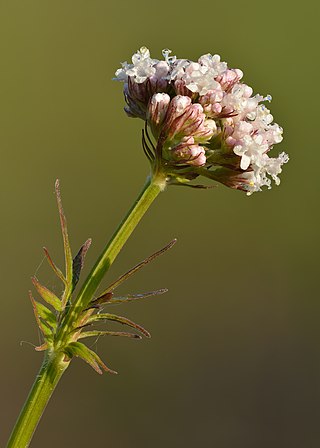
Valerian is a perennial flowering plant native to Europe and Asia. In the summer when the mature plant may have a height of 1.5 metres, it bears sweetly scented pink or white flowers that attract many fly species, especially hoverflies of the genus Eristalis. It is consumed as food by the larvae of some Lepidoptera species, including the grey pug.

The Caprifoliaceae or honeysuckle family is a clade of dicotyledonous flowering plants consisting of about 860 species, in 33, to 42 genera, with a nearly cosmopolitan distribution. Centres of diversity are found in eastern North America and eastern Asia, while they are absent in tropical and southern Africa.

Curtisia dentata is a flowering tree from Southern Africa. It is the sole species in genus Curtisia, which was originally classed as a type of "dogwood" (Cornaceae), but is now placed in its own unique family Curtisiaceae.
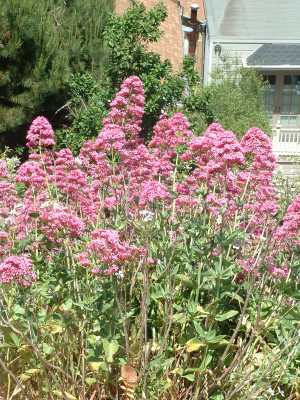
The Valerianaceae Batsch, the valerian family, was a family of flowering plants that is now considered part of the Caprifoliaceae. Plants are generally herbaceous, and their foliage often has a strong, disagreeable odor. They are found native in most regions of the world except for Australia. Some species are cultivated as ornamentals or used in herbal medicine for inducing relaxation and sleep.
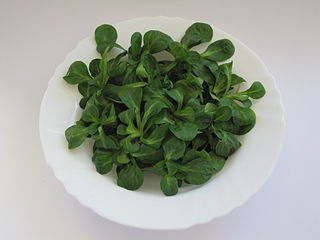
Valerianella locusta is a synonym for Valeriana locusta, commonly called mâche, cornsalad, or lamb's lettuce, a small, herbaceous, annual flowering plant in the honeysuckle family Caprifoliaceae. It is native to Europe, western Asia and north Africa, where it is eaten as a leaf vegetable.

Valeriana is a genus of flowering plants in the family Caprifoliaceae, members of which may by commonly known as valerians. It contains many species, including the garden valerian, Valeriana officinalis. Species are native to all continents except Antarctica, with centers of diversity in Eurasia and South America.

Ranscombe Farm, in Cuxton in North Kent, is a Plantlife Nature Reserve and working farm. Part of the site is included in the Cobham Woods Site of Special Scientific Interest, and the whole farm is within the Kent Downs Area of Outstanding Natural Beauty.
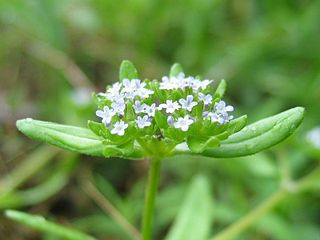
Valerianella is a genus of flowering plant in family Caprifoliaceae. Many plants of this genus are known by the common name corn salad or cornsalad, although that name most often refers to Valerianella locusta.

Valerianella nuttallii, or Nuttall's cornsalad, is a small dicot annual plant of the family Caprifoliaceae which can be found growing within the United States in areas of Oklahoma and Arkansas.

Valeriana congesta, synonym Plectritis congesta, is a species of flowering plant in the honeysuckle family. It is known by several common names, including shortspur seablush and rosy plectritis. It is native to western North America.
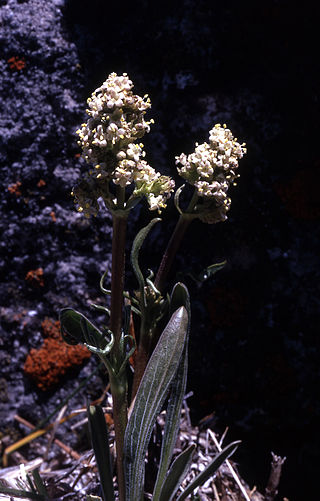
Valeriana edulis, the tobacco root or edible valerian, a species of flowering plant in the family Caprifoliaceae, is a dioecious perennial herb native to western and central North America. Despite its common name, tobacco root is not closely related to tobacco, but is instead more closely related to elderberry, honeysuckle, and teasel.

Valerianella radiata, synonyms Valerianella stenocarpa and Valerianella woodsiana, common name beaked cornsalad, is a plant native to the United States. It is an annual self pollinating flowering plant and besides being edible there are no known uses. Valerianella radiata flowers from April- May.
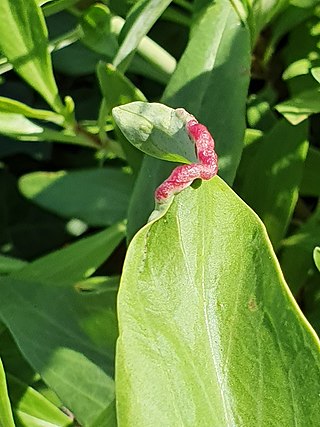
Trioza centranthi is a sap-sucking hemipteran bug in the family Triozidae which creates galls on the leaves and flowers of Centranthus and Valerianella species. It was first described by Jean Nicolas Vallot, a French entomologist in 1829 and is found in Europe.
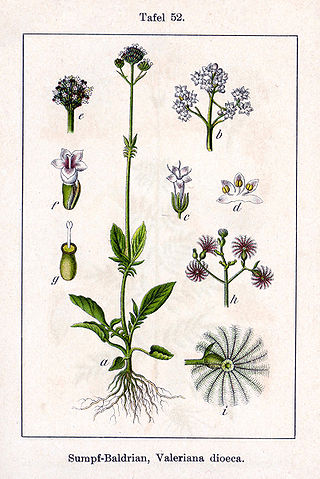
Valeriana dioica, the marsh valerian, is a species of flowering plant in the family Caprifoliaceae, native to North America, Europe and Anatolia. It is typically found in calcareous fens. It is a dioecious species, with male and female flowers on separate individuals, and it is pollinated by small flies.

Valerianella eriocarpa is a synonym for Valeriana eriocarpa (Desv.) Christenh. & Byng, a species of flowering plant in the family Caprifoliaceae.
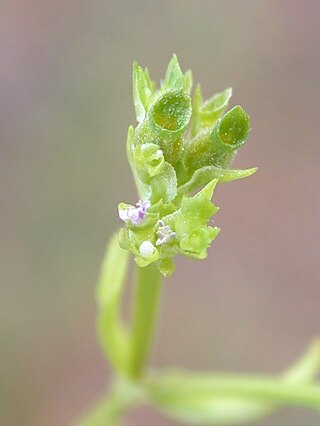
Valerianella muricata is a species of plants in the family Caprifoliaceae.

Valerianella umbilicata, is a synonym for Valeriana umbilicata known by the common name navel cornsalad. It is a dicot, annual plant in the flowering plant family Caprifoliaceae. It is native to the Eastern North America and some parts of Canada and has no known uses other than being edible.

















